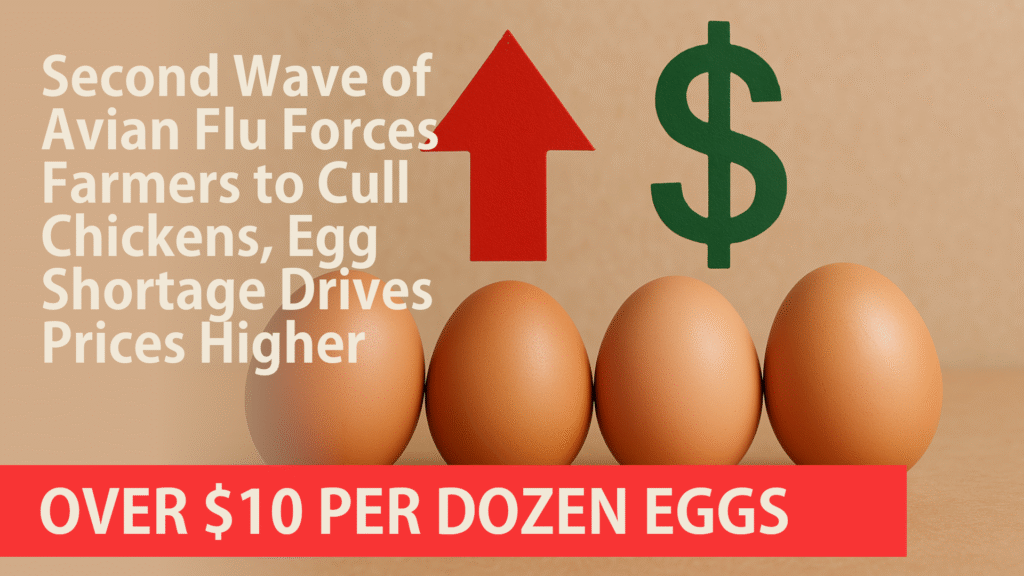
A second wave of avian influenza has swept across the nation, compelling farmers to cull their flocks of chickens in an attempt to halt the spread of the deadly virus. The new outbreak has already led to severe disruptions in the poultry industry, worsening the ongoing egg shortage and driving prices to unprecedented highs.
As farmers are forced to destroy their infected chickens to contain the virus, the United States faces a massive reduction in egg production. This comes on the heels of last year’s supply chain disruptions, which had already driven prices up by nearly 50%. With eggs now soaring above $10 per dozen, consumers and businesses alike are feeling the financial strain.
Eggs: A Commodity in Crisis
The price surge is creating an economic ripple effect that’s being felt at every level of the food chain. In grocery stores across the country, shoppers are faced with sticker shock as the cost of eggs escalates. At some major grocery chains, the price per dozen has jumped as high as $12.98, while specialty organic eggs are pushing $18.
For many consumers, eggs have become a luxury they can no longer afford. “I used to buy a dozen eggs every week,” said Emma Richardson, a mother of two from Chicago. “Now, I’m cutting back. I can’t justify paying that much for something that used to be a staple in our household.”
The high price tag is forcing families to reassess their eating habits, with many turning to egg alternatives like tofu or plant-based substitutes. Health-conscious individuals are also shifting their focus to egg-free diets, capitalizing on the growing trend of plant-based foods. However, for others, the cost of alternatives is equally prohibitive, leaving many scrambling for ways to stretch their budgets.
Restaurants and Bakeries Face Tough Choices
The egg shortage is also hitting restaurants and bakeries hard. In the face of mounting costs, many establishments are being forced to raise prices, passing the extra expense directly onto customers. Fine dining restaurants, quick-service eateries, and bakeries are reporting significant challenges in maintaining their menus while keeping up with the skyrocketing cost of eggs.
“We’re asking our customers to save eggs for us,” said Bella Hayes, owner of Flour & Whisk Bakery in New York. “The prices are so high right now that we’re having to choose between cutting menu items or charging more for the ones that require eggs. It’s a delicate balance.”
Many bakeries and restaurants have already started cutting back on their egg-based offerings, opting for fewer dishes that require eggs or sourcing eggs from specialty suppliers at higher prices. In some cases, popular egg-based menu items, like omelets or breakfast burritos, are becoming rarer on menus, and when available, they are priced at a premium.
Some businesses have even started offering “egg-saving” initiatives, asking customers to bring in their own eggs for a discount on certain menu items. While creative, this solution has had limited success, with most customers too wary of the new financial strain to take part.
Changing Eating Habits
As the prices of eggs climb, people are altering their food consumption habits. Surveys show that nearly 60% of Americans are now eating fewer egg-based products, including baked goods and breakfast items, in order to save money. This shift is impacting everything from pastries to prepared foods, with bakeries reporting a 25% drop in egg-based product sales since the outbreak of the second wave of avian flu.
“We’re seeing fewer people coming in for quiches, egg tarts, and pastries like croissants,” said Sarah Kim, who manages a popular bakery in San Francisco. “It’s really hard because those items are a big part of our menu. People are rethinking what they want to spend their money on.”
The egg shortage and the subsequent price hike have caused broader changes in consumer behavior. For some, it’s a wake-up call about food security and reliance on one type of agricultural product. The public is increasingly turning to alternatives such as vegan or plant-based products, which, though sometimes expensive, are gaining popularity.
Impact on Food Security and the Long-Term Outlook
Experts are warning that the egg shortage could last for several months or even years. As the avian flu continues to spread, many regions are under heightened biosecurity protocols to protect remaining poultry flocks. The U.S. Department of Agriculture (USDA) is working to combat the virus through vaccines and enhanced monitoring, but experts caution that recovery from this crisis will take time.
“Avian flu outbreaks have a ripple effect that goes far beyond the immediate culling of affected birds,” said Dr. Angela Thompson, an epidemiologist at the Centers for Disease Control and Prevention (CDC). “The long-term repercussions on egg prices and availability are something we will be dealing with for quite some time.”
In the meantime, consumers are adjusting to this new reality, with eggless diets becoming a norm in many households. For some, it’s an inconvenience. For others, it’s an opportunity to explore new food choices and become more self-sufficient in their kitchens.
As the pandemic rages on in the poultry industry, the question on many minds is how long this crisis will last, and whether consumers will ever see affordable eggs again.
A Changing World
The resurgence of avian flu is a harsh reminder of how fragile our food systems can be. While the situation remains fluid, one thing is clear: eggs may no longer be the everyday essential they once were. And as the price of this essential ingredient continues to climb, the world is learning to adapt—whether they like it or not.